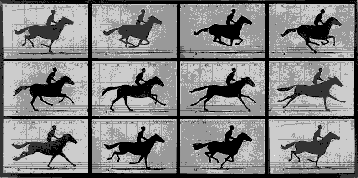Technical Components
CLICK TO VISIT THE MIRO BOARD
Casting the Parts: The Algorithm of Celluloid Film
Here, we have a map of the multiple technologies that allow the strip film to played into the motion picture that we commonly refer to as a "film" or "movie" today.
The creation of films as motion pictures is based on two amazing optical phenomena: persistence of vision and phi phenomenon. When images are cast upon the retina of the eye, the former one makes the brain retain the images for a fraction of some seconds after the images’ disappearance from the sight, while the latter one creates movement between images that are presented one after another rapidly.
Before celluloid, paper and glasses were used as the film base. Now we are going to focus on the celluloid film itself, to take a close look at its architecture and discuss why this invention is able to record the image, carry the sound, and work with a film projector to produce true motion pictures.
Click the pictures to visit the original websites
Image
1,2,3……click!
Let’s see how images on presented on the plastic film base. Chemicals, light, sensors, and more are all applied to the celluloid film strip in order to make an image appear on the screen.
The film base is made up of several layers. For a B&W film, the emulsion on the surface with silver halide crystal inside is the secret to form a picture. When exposed to light, a chemical reaction darkens the film to produce an image. While in the color film, the color is produced by three main color layers (blue, red & green) that contain silver halide crystals and dye-couplers. For both B&W film and color film, the image needs to be fixed on the film base by bathing in chemicals (developers) in a darkroom.
Sound
soundtrack on the film →
Quiet on set!
Celluloid film captures the sound waves produced on set. Several well-known technologies, like a microphone, amplifier, and camera reflect onto the film, allowing sound to be recorded as a soundtrack.
Sound is created by vibration in the air and then transformed into electrical impulses by a microphone. The sound technician applies the amplifier to pass these impulses to the straight coil film inside the camera's lamp. A wire connected to a small mirror inside the camera is thus activated to cast light on the film. In this way, the film successfully captures the sound wave on its soundtrack.
Film Projector
And... ACTION!
The celluloid film is fed through the projector and casts the film onto the big screen for the audience. The film's shape and its perforated sides also contribute to the moving image.
In the projector, there is an eccentric arm that makes every component move together, including reels and a shuttle with three teeth. The shuttle starts and stops the film by putting its teeth into the holes on the side of the film. There is also a lamp with a shutter on the side. The shutter can strategically block the light and eliminate blurring when the image is moving. And the sound is read by the photosensor and played by the speaker.








